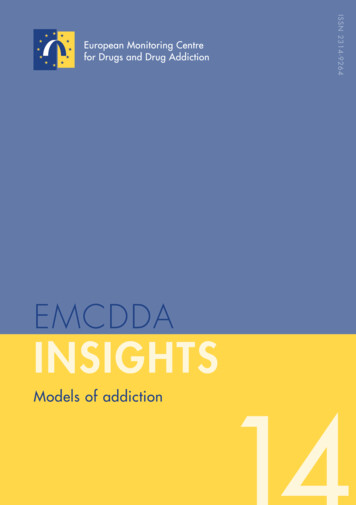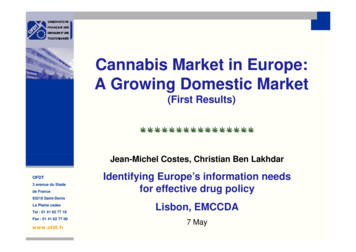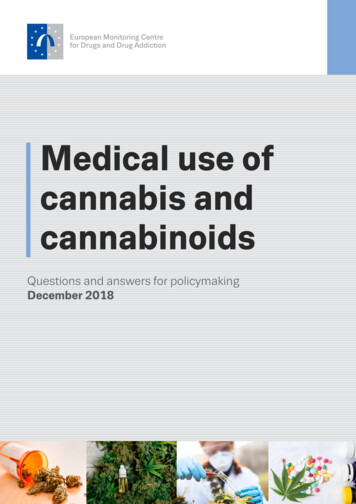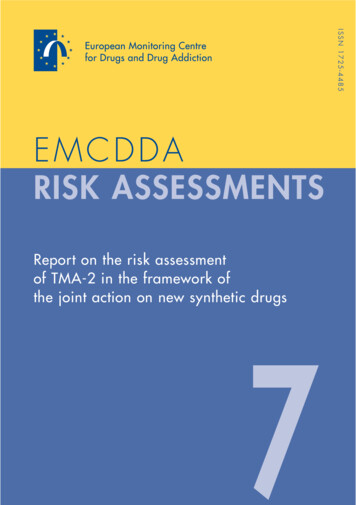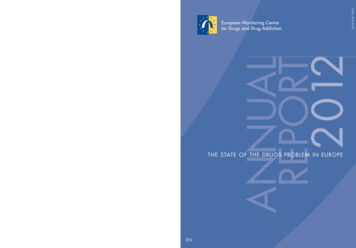
Transcription
2012ANNUALREPORTThe Centre’s publications are a prime source of information for a wideaudience including policymakers and their advisers; professionals andresearchers working in the field of drugs; and, more broadly, the mediaand general public.I S S N 16 0 9- 6150The EMCDDA collects, analyses and disseminates factual, objective,reliable and comparable information on drugs and drug addiction; indoing so, it provides its audience with an evidence-based picture of thedrug phenomenon at European level.A N N UA L R E P O RT 2012: T H E S TAT E O F T H E D RU G S P RO B L E M I N EU RO P EThe European Monitoring Centre for Drugs and Drug Addiction (EMCDDA)is one of the European Union’s decentralised agencies. Established in 1993and based in Lisbon, it is the central source of comprehensive informationon drugs and drug addiction in Europe.T D - AC -12- 0 01- EN - CAbout the EMCDDAThe annual report presents the EMCDDA’s yearly overview of the drugphenomenon in the EU and is an essential reference for those seeking thelatest findings on drugs in Europe.TH E STATE O F TH E DRU GS PRO BLEM IN EU RO PEEN
HOW TO OBTAIN EU PUBLICATIONSFree publications: via EU Bookshop (http://bookshop.europa.eu); a t the European Union’s representations or delegations. You can obtain their contact detailson the Internet (http://ec.europa.eu) or by sending a fax to 352 2929-42758.Priced publications: via EU Bookshop (http://bookshop.europa.eu).Priced subscriptions (e.g. annual series of the Official Journal of the European Unionand reports of cases before the Court of Justice of the European Union): v ia one of the sales agents of the Publications Office of the European index en.htm).
2012ANNUALREPORTTHE STATE O F TH E DRU GS PRO BLEM IN EU RO PE
Legal noticeThis publication of the European Monitoring Centre for Drugs and Drug Addiction (EMCDDA) is protected bycopyright. The EMCDDA accepts no responsibility or liability for any consequences arising from the use of thedata contained in this document. The contents of this publication do not necessarily reflect the official opinionsof the EMCDDA’s partners, the EU Member States or any institution or agency of the European Union.A great deal of additional information on the European Union is available on the Internet. It can beaccessed through the EUROPA server (http://europa.eu).Europe Direct is a service to help you find answers to your questions about the European Union.Freephone number (*):00 800 6 7 8 9 10 11(*) Certain mobile telephone operators do not allow access to 00 800 numbers or these calls may be billed.This report is available in Bulgarian, Spanish, Czech, Danish, German, Estonian, Greek, English, French,Italian, Latvian, Lithuanian, Hungarian, Dutch, Polish, Portuguese, Romanian, Slovak, Slovenian, Finnish,Swedish and Norwegian. All translations were made by the Translation Centre for the Bodies of theEuropean Union.Cataloguing data can be found at the end of this publication.Luxembourg: Publications Office of the European Union, 2012ISBN 978-92-9168-538-7doi:10.2810/64775 European Monitoring Centre for Drugs and Drug Addiction, 2012Reproduction is authorised provided the source is acknowledged.Printed in LuxembourgPrintedon white chlorine - free paperCais do Sodré, 1249-289 Lisbon, PortugalTel. 351 211210200 Fax 351 218131711info@emcdda.europa.eu www.emcdda.europa.eu
ContentsForeword 5Acknowledgements 7Introductory note 9Commentary: Building on achievements, maintainingmomentum and responding to change — the challengefor drug policy in Europe today 13Chapter 1: Policies and laws EU and international policy developments National strategies Public expenditure National legislation Research 20Chapter 2: Responding to drug problemsin Europe — an overview Prevention Treatment Social reintegration Harm reduction Quality standards Drug law enforcement and offences 28Chapter 3: Cannabis Supply and availability Prevalence and patterns of use Adverse health effects Treatment 39Chapter 4: Amphetamines, ecstasy, hallucinogens,GHB and ketamine Supply and availability Prevalence and patterns of use Health consequences Prevention in recreational settings Treatment 49Chapter 5: Cocaine and crack cocaine Supply and availability Prevalence and patterns of use Health consequences Problem use Treatment and harm reduction 60Chapter 6: Opioid use and drug injection Supply and availability Problem use Injecting drug use Treatment 70Chapter 7: Drug-related infectious diseasesand drug-related deaths Infectious diseases Responding to infectious diseases Deaths and mortality Reducing deaths 79Chapter 8: New drugs and emerging trends Action on new drugs Production and supply Prevalence Responses 89References 953
ForewordThis is the EMCDDA’s 17th annual report on the state ofthe drugs problem in Europe, and it is gratifying whenlooking back over the years to note how much progresshas been made in developing a sound understandingof the European drug phenomenon. This is not anachievement of the EMCDDA alone; credit must also goto the Member States of the European Union, which havelong recognised the value of developing a comprehensivepicture of Europe’s drug problem. And, while we are veryproud of the work of the EMCDDA staff in producing thispublication, we also have to acknowledge that it is verymuch a collective effort. This report is only made possibleby the support and hard work of our partners, especiallythose in the Reitox network, who provide the national dataon which the analysis is based. We are also indebted tothe many other European and international agencies andbodies that support our work.from drug markets and interdiction efforts, to drug use,This year’s report comes at an important and difficulttime for Europe. Many countries are experiencingfinancial and economic problems, and this must form thebackdrop for our reporting. The austerity measures thatare being adopted bring multiple challenges, and presentpolicymakers with difficult choices as competing prioritiescall on the public purse. In such times, it is more importantthan ever that investments are made wisely, based onan understanding of the nature of the problem and whatmeasures are likely to deliver the greatest benefits. TheEMCDDA’s mission is to work with experts from acrossEurope to provide this analysis. You will find here, and inthe accompanying web-based elements, an up-to-date,scientifically robust and comprehensive overview of thecontemporary European drugs problem, together withexamples of innovative and good practice.situation.When considering drug issues, there can be a tendencyto be reductive, focusing only on individual elements inthis complex problem, as though they exist in isolation.This is not the approach we adopt here. In our view,the strength of the EMCDDA’s analysis is that it bringstogether disparate information on topics that rangedemand reduction responses and policy and legaldevelopments. This allows us to provide a holistic analysiswhich is greater than the sum of its parts. You cannotfully understand supply issues if you do not understandthe drivers of drug demand and vice versa. For example,to understand the changes that we are seeing in heroinavailability in Europe today, we need to take into accountthe impact of interdiction efforts that have effectivelytargeted major crime organisations. But, critically, weneed to also consider that this has taken place at a timewhen an increase in investment in treatment has removeda significant part of the demand from the marketplace.As you will see from our report this year, these areequally important pieces of information that need to beconsidered together in order to achieve a sound overviewof the developments we are seeing in the European heroinWe need this breadth of vision if we are to respond tothe complex and dynamic nature of the drug problemin Europe today. We are presented with a range ofchallenges, both new and old. They may be linked toadvances in information and communication technology,the spread of new psychoactive substances, and increasedavailability and use of synthetic drugs. Or they may stemfrom long-established problems that continue to defy ourresponses, and cause damage to both individuals andcommunities. The EMCDDA is committed to providingthe evidence base to ensure that the debate on drugsin Europe remains informed by a comprehensive,dispassionate and, most importantly, helpful understandingof this complex issue.João GoulãoChairman, EMCDDA Management BoardWolfgang GötzDirector, EMCDDA5
AcknowledgementsThe EMCDDA would like to thank the following for their help in producing this report: the heads of the Reitox national focal points and their staff; the services and experts within each Member State that collected the raw data for this report; the members of the Management Board and the Scientific Committee of the EMCDDA; t he European Parliament, the Council of the European Union — in particular its Horizontal Working Party on Drugs —and the European Commission; the European Centre for Disease Prevention and Control (ECDC), the European Medicines Agency (EMA) and Europol; t he Pompidou Group of the Council of Europe, the United Nations Office on Drugs and Crime, the WHO RegionalOffice for Europe, Interpol, the World Customs Organisation, the European school survey project on alcohol and otherdrugs (ESPAD) and the Swedish Council for Information on Alcohol and other Drugs (CAN), the Controlled Substancesand Tobacco Directorate of Health Canada, the US Substance Abuse and Mental Health Services Administration; the Translation Centre for Bodies of the European Union and the Publications Office of the European Union.Reitox national focal pointsReitox is the European information network on drugs and drug addiction. The network is comprised of national focal pointsin the EU Member States, Norway, the candidate countries and at the European Commission. Under the responsibility of theirgovernments, the focal points are the national authorities providing drug information to the EMCDDA.The contact details of the national focal points may be found on the EMCDDA website.7
Introductory noteThis annual report is based on information provided tothe EMCDDA by the EU Member States, the candidatecountries Croatia and Turkey, and Norway in the form ofa national report. The statistical data reported here relateto the year 2010 (or the last year available). Graphics andtables in this report may reflect a subset of EU countries;the selection may be made on the basis of those countriesfrom which data are available for the period of interest, orto highlight certain trends.Analysis of trends is based only on those countriesproviding sufficient data to describe changes over theperiod specified. Figures for 2009 may substitute formissing 2010 values in trend analysis of drug marketdata; for the analysis of other trends, missing data may beinterpolated.Background information and a number of caveats thatshould be borne in mind when reading this annual reportare presented below.Drug supply and availability dataSystematic and routine information to describe illicit drugmarkets and trafficking is still limited. Production estimatesof heroin, cocaine and cannabis are obtained fromcultivation estimates based on fieldwork (sampling on theground) and aerial or satellite surveys. These estimateshave some important limitations linked, for example, tovariations in yield figures or the difficulty of monitoringcrops such as cannabis, which may be grown indoors orare not restricted to certain geographical areas.Drug seizures are often considered as an indirect indicatorof the supply, trafficking routes and availability of drugs.They are a more direct indicator of drug law enforcementactivities (e.g. priorities, resources, strategies), while alsoreflecting both reporting practices and the vulnerability oftraffickers. Data on purity or potency and retail prices ofillicit drugs may also be analysed in order to understandretail drug markets. Retail prices of drugs reported to theEMCDDA reflect the price to the user. Trends in price areadjusted for inflation at national level. Reports on purityor potency, from most countries, are based on a sample ofall drugs seized, and it is generally not possible to relatethe reported data to a specific level of the drug market.For purity or potency and retail prices, analyses are basedon the reported mean or mode or, in their absence, themedian. The availability of price and purity data may beAccessing this annual report and its datasources on the InternetThis annual report is available for downloading in22 languages on the EMCDDA website. The electronicversion contains links to all online sources cited in thisannual report.The following resources are available only on the Internet.The 2012 statistical bulletin presents the full set of sourcetables on which the statistical analysis in this annual reportis based. It also provides further detail on the methodologyused and about 100 additional statistical graphs.The national reports of the Reitox focal points givea detailed description and analysis of the drugs problemin each country.Country overviews provide a top-level, graphical summaryof key aspects of the drug situation for each country.limited in some countries and there may be questions ofreliability and comparability.The EMCDDA collects national data on drug seizures,purity and retail prices in Europe. Other data on drugsupply comes from UNODC’s information systems andanalyses, complemented by additional information fromEuropol. Information on drug precursors is obtainedfrom the European Commission, which collects dataon seizures of these substances in the EU, and theInternational Narcotics Control Board (INCB), which isinvolved in international initiatives to prevent the diversionof precursor chemicals used in the manufacture of illicitdrugs.The data and estimates presented in this report are thebest approximations available, but must be interpretedwith caution as many parts of the world still lacksophisticated information systems related to drug supply.Prevalence of drug use as measuredby general population surveysDrug use in the general or school population can bemeasured through representative surveys, which provideestimates of the proportion of individuals that reporthaving used specific drugs over defined periods of time.Surveys also provide useful contextual information onpatterns of use, socio-demographic characteristics of usersand perceptions of risks and availability.9
Annual report 2012: the state of the drugs problem in Europe10The EMCDDA, in close collaboration with nationalexperts, has developed a set of core items for use in adultsurveys (the ‘European Model Questionnaire’, EMQ).This protocol has now been implemented in most EUMember States. However, there are still differences inthe methodology used and year of data collection, andthis means that small differences, in particular betweencountries, should be interpreted with caution.The European school survey project on alcohol andSurveys are expensive to conduct and few Europeancountries collect information each year, although manycollect data at intervals of two to four years. In thisreport, data are presented based on the most recentsurvey available in each country, which, in most cases, isbetween 2006 and 2010. Prevalence data for the UnitedKingdom refer to England and Wales, unless otherwisestated, although separate data for Scotland and NorthernIreland are also available.national surveys of school students, which provide data onOf the three standard time frames used for reportingsurvey data, lifetime prevalence (use of a drug at anypoint in one’s life) is the broadest. This measure does notreflect the current drug-use situation among adults, but canbe helpful to understand patterns of use and incidence.For adults, the EMCDDA’s standard age ranges are 15–64(all adults) and 15–34 (young adults). Countries usingdifferent upper or lower age limits include: Denmark (16),Germany (18), Hungary (18), Malta (18), Sweden (16) andthe United Kingdom (16–59). The focus is on the last yearand last month time frames (use during the last 12 monthsor last 30 days before the survey) (for more information,see the EMCDDA website). For school students, lifetimeand last year prevalence are often similar, as illicit druguse before age 15 is rare.and social characteristics. The time frame for annualother drugs (ESPAD) uses standardised methods andinstruments to measure drug and alcohol use amongrepresentative samples of school students who turn 16during the calendar year. In 2011, data were collectedin 36 countries, including 24 EU Member States, Croatiaand Norway, and the results were published in 2012.In addition, Spain and the United Kingdom carry outdrug use comparable to the results of the ESPAD surveys.Treatment demandData on those entering treatment in Europe for problemsrelated to their drug use are reported anonymously to theEMCDDA treatment demand indicator. Each client enteringtreatment is queried on their drug use, treatment contacttreatment entry data is 1 January to 31 December. Clientsin continuous treatment at the start of the year in questionare not included in the data. Where the proportion oftreatment demands for a primary drug is given, thedenominator is the number of cases for which the primarydrug is known.InterventionsInformation on the availability and provision of variousinterventions in Europe is generally based on the informedjudgement of national experts collected through structuredquestionnaires. However, for some indicators, quantitativemonitoring data are also available.
CommentaryBuilding on achievements, maintaining momentum and respondingto change — the challenge for drug policy in Europe todayEnhancing coordination and cooperationA strong message emerging from the EMCDDA’s latestanalysis of the European drug situation is that there isa need to keep ‘an eye on the ball’ with regard to theproblems related to established drugs, while at the sametime developing responses to new threats and challenges.Heroin and cocaine continue to account for a large shareof the harm, morbidity and mortality associated withdrug use in Europe. Here, it will be necessary to maintainmomentum in the development and implementationof evidence-based responses. In many respects,considerable, if uneven, progress has been made, but thiscould easily be put at risk by changing circumstances orby a failure to continue to scale up responses. The analysisalso highlights the need to strengthen Europe’s capacityto identify and respond to the challenges posed by anincreasingly complex and dynamic drug marketplace.These needs must be seen in the context of the difficultfinancial situation in many European countries, whichmeans that resources for addressing health and socialproblems of all descriptions are in short supply. In thesecircumstances, it is essential to ensure that the availablefunds are invested in well-targeted activities of proveneffectiveness. One way that this can be achieved is bycooperation between EU Member States, in which theyseek to maximise the benefits of activities through sharingexperiences, working together or better coordinating theiractions. The policy framework for this is provided by theEU drug strategy and its accompanying action plans.The current EU strategy (2005–12) has been positivelyevaluated, with particular importance given to its role infacilitating information exchange.A new policy framework is now under considerationto follow on from the 2005–12 drug strategy. The newframework is likely to maintain its emphasis on the needfor an evidence-based and balanced approach whichencompasses a comprehensive set of demand and supplyreduction measures. Monitoring, research and evaluation,as well as respect for fundamental human rights, are alsolikely to remain key elements of the EU approach. Thenew policy framework will also ensure synergy betweenactivities in the drugs field and broader issues relatedto security and health, in which drugs are only onecomponent, such as HIV prevention or the fight againstorganised crime. The new framework will also help toensure that Europe speaks with a strong and united voicein the international debate on drugs.A complicated picture: the cannabis market in EuropeThis year, the EMCDDA undertook a major new analysisof the cannabis market, which revealed an increasinglycomplex and diverse picture for Europe’s most used illicitdrug. A number of different cannabis ‘products’ are nowavailable on the European market, with the most importantdistinction being between herbal cannabis and cannabisresin. The rise of cannabis production within the EuropeanUnion has resulted in the increasing displacement ofimported cannabis resin by home-produced herbalcannabis products. Domestic cannabis production variesconsiderably. It can take the form of large plantations,where the plant is grown intensively using sophisticatedtechniques to maximise yield and potency. At the otherend of the spectrum, small numbers of cannabis plantsmay be grown by users for personal consumption.Although most cannabis offences are still related to theuse or possession of the drug, many countries report thattheir policy is to prioritise measures targeting traffickingand supply. In this context, greater emphasis is nowreported to be given to targeting intensive productionsites. However, despite increases in the number of plantsseized and the development of some innovative newdetection methods, Europe still seizes far more cannabisresin than herbal cannabis. This suggests that domesticherbal cannabis production can pose a greater challengefor interdiction efforts, especially when it takes the formof intensive indoor production. Concern is growing aboutdevelopments in this area: both because of the collateraldamage that the presence of drug production sites cancause to local communities and because of evidence ofthe involvement of organised criminal gangs.The scale and complexity of the cannabis market is notsurprising as it reflects the position of the drug as Europe’s13
Annual report 2012: the state of the drugs problem in Europemost popular illicit substance. Correspondingly, it is alsothe substance where political and public sentiment is mostdivided. Interestingly, levels of cannabis consumptionoverall appear relatively stable, and there may even bea decline in use in some countries. Although difficult tomeasure, cannabis-related problems are also now betterunderstood and known to be associated with the intensiveand long-term use of the drug. Some worries exist here.The shift towards herbal cannabis, for example, may beexposing users to more potent forms of the drug. Moreover,studies report that the age of initiation is now quite lowfor many users. An estimated 1 % of the European adultpopulation is using the drug on a daily basis, and amongyoung males in particular, intensive patterns of use can berelatively common in some countries. Taken as a whole, anyoptimism engendered by a stabilisation in prevalence levelsneeds to be tempered by the recognition that this drugremains an important public health issue, reflected in thenumber of demands for drug treatment related to its use.Today’s European students: a more cautious cohortThe latest results from the European school surveyproject on alcohol and other drugs (ESPAD) provide animportant window on time trends in substance use amongschoolchildren. Promisingly, for all the major substances,the 2011 findings suggest a reduction or stable situation.Over the five rounds of the survey, recent cigarette usesteadily decreased between 1999 and 2007, then stabilised.Students’ recent use of alcohol has gradually declined overallin Europe since 2003, while the latest data indicate that theupward trend for heavy episodic drinking, observed from1995 to 2007, may now be past its peak. Overall, students’experience of illicit drugs — predominantly cannabis — wasrising until 2003, dropped slightly in 2007 and since thenhas remained stable. These findings may provide us with anindication of future trends, as patterns found here may laterfeed through into older age cohorts.An interesting observation is that countries that reporthigh prevalence estimates for one substance, tend also toreport relatively high estimates for other substances, bothlicit and illicit, thus high levels of recent use of alcohol andheavy episodic drinking are associated with the use ofillicit drugs and inhalants. This finding supports preventionapproaches that recognise the need to target both drugsand alcohol when working with young people.Drugs and the family: an overlooked issueand underused resourceIndividuals take drugs, but often their families mustshare the problems that their consumption can cause.14Families and the related issue of drug users with parentalresponsibility are analysed in a new EMCDDA study.The report finds that although those with drug problemsdo not necessarily make bad parents, they are likelyto require additional support. Treatment services, inparticular, must be sensitive to the needs of those whohave parental responsibility, as worries about childcareor child protection can act as a barrier to seeking help.Working with drug-using parents is also challenging forservices, as it requires balancing the rights of the parentand of the child; however, the report concludes thatgood practice and well-targeted interventions can makea real difference. This finding is echoed in the analysisof interventions that target pregnant drug users, wherethere is strong evidence that the provision of appropriateadvice and support can improve the outcome for bothmother and child.Many studies have explored the stress and socialdisruption that can result from having a family memberwith a drug problem. Family support services, however,are generally poorly developed in most Europeancountries. This can mean that an important resource forsupporting recovery is being overlooked. A focus onthe family environment is also becoming increasinglyimportant for drug prevention work, where a growingevidence base points to the effectiveness of broad-basedprevention strategies that target both the environment andthe individual. The family is particularly important in thisrespect, and environmental prevention strategies that workto establish stronger families may lower the risk of a rangeof problematic behaviours, including drug use. Despitethe positive findings for interventions in this area, the factthat they remain, to a large extent, poorly developed,highlights the more general problem that findings fromresearch on prevention often fail to be translated intopolicies and practice.Drug-using prisoners: a vulnerable populationDespite increasing interest in providing ‘alternatives toprison’, many people with drug problems continue topass through Europe’s prisons every year. This is reflectedin study data showing that drug problems are far morecommon in prisoners than in the general population.Although some do stop using drugs when incarcerated,the availability of drugs in some prisons also means thatothers may initiate drug use, or start engaging in moredamaging behaviours. Injecting drug users, for example,may share equipment more frequently, heightening the riskof the transmission of blood-borne pathogens such as HIVand hepatitis C virus.
Commentary: The challenge for drug policy in Europe todayAt a glance — estimates of drug use in EuropeThe estimates presented here relate to the adult population(15–64) and are based on the most recent data available(surveys conducted between 2004 and 2010/11, mainly2008–10). For the complete set of data and information onthe methodology see the accompanying statistical bulletin.CannabisLifetime prevalence: about 80.5 million(23.7 % of European adults)Last year use: about 23 million European adults (6.8 %)or one in three lifetime usersLast month use: about 12 million (3.6 %)Country variation in last year use:overall range 0.3 % to 14.3 %CocaineLifetime prevalence: about 15.5 million(4.6 % of European adults)Last year use: about 4 million European adults (1.2 %)or one in four lifetime usersLast month use: about 1.5 million (0.5 %)Country variation in last year use:overall range 0.1 % to 2.7 %EcstasyLifetime prevalence: about 11.5 million(3.4 % of European adults)Last year use: about 2 million (0.6 %)or one in six lifetime usersCountry variation in last year use:overall range 0.1 % to 1.6 %AmphetaminesLifetime prevalence: about 13 million(3.8 % of European adults)Last year use: about 2 million (0.6 %)or one in six lifetime usersCountry variation in last year use:overall range 0.0 % to 1.1 %OpioidsProblem opioid users: estimated at about1.4 million EuropeansAbout 710 000 opioid users received substitutiontreatment in 2010Principal drug in about 50 % of all drugtreatment requestsDrug-induced deaths accounted for 4 % of all deaths ofEuropeans aged 15–39, with opioids being found in aboutthree quarters of casesOvercrowding, poor hygiene and a lack of healthcareprovision affect many prisons, and contribute to the overallpoor health status found in prison populations. Prisonerswith drug problems may be doubly disadvantaged in thisrespect, and may be especially vulnerable to both physicaland mental health problems while incarcerated — withparticular concerns existing about their elevated risk ofself-harm and suicide. A strong argument therefore existsthat any successful approach to improving prison healthmust recognise the importance of including drug treatmentalongside, and integrated with, more generic physical andmental healthcare responses.Where adequate services are in place, periods ofincarceration may provide an opportunity for someto reduce their drug use and engage with services.Opportunities in
and general public. The annual report presents the EMCDDA's yearly overview of the drug phenomenon in the EU and is an essential reference for those seeking the latest findings on drugs in Europe. TD-AC-12-001-EN-C ISSN 1609-6150 THE STATE OF THE DRUGS PROBLEM IN EUROPE ANNUAL REPORT EN 20 12


